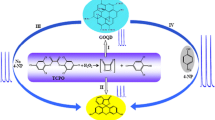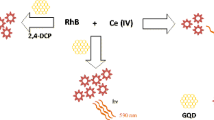Abstract
A method is described for the colorimetric determination of chromate [chromium(VI)]. It is based on the use of graphene oxide (GO) nanoparticles acting as a peroxidase mimic. A blue color is generated by oxidation of 3,3,5,5-tetramethylbenzidine by H2O2 which is catalyzed by GO. This color-forming reaction is prevented in the presence of 8-hydroxyquinoline (8-HQ). However, in the presence of Cr(VI), the blue color will be formed from TMB owing to the oxidation of the inhibitor 8-HQ by Cr(VI). The color can be measured by a spectrophotometry (at 652 nm) or detected visually. Under optimal experimental conditions, response is linear in the 50 to 430 nM range of chromate concentration, and the limit of detection is 5.8 nM (at S/N = 3). The assay is highly selective and was successfully applied to the determination of Cr(VI) in spiked water samples.

Schematic of the colorimetric assay for Cr(VI). TMB: 3,3,5,5-tetramethylbenzidine





Similar content being viewed by others
References
Luo S, Xiao Y, Yang L, Liu C, Su F, Li Y, Cai Q, Zeng G (2011) Simultaneous detoxification of hexavalent chromium and acid orange 7 by a novel au/TiO2 heterojunction composite nanotube arrays. Sep Purif Technol 79(1):85–91
Yu H, Chen S, Quan X, Zhao H, Zhang Y (2008) Fabrication of a TiO2−BDD heterojunction and its application as a Photocatalyst for the simultaneous oxidation of an azo dye and reduction of Cr(VI). Environ Sci Technol 42(10):3791–3796
Liu X, Xiang JJ, Tang Y, Zhang XL, Fu QQ, Zou JH, Lin YH (2012) Colloidal gold nanoparticle probe-based immunochromatographic assay for the rapid detection of chromium ions in water and serum samples. Anal Chim Acta 745:99–105
Zhang Y, Fang X, Zhao H, Li Z (2018) A highly sensitive and selective detection of Cr(VI) and ascorbic acid based on nitrogen-doped carbon dots. Talanta 181:318–325
Chwastowska J et al (2005) Speciation of chromium in mineral waters and Salinas by solid-phase extraction and graphite furnace atomic absorption spectrometry. Talanta 66(5):1345–1349
Arancibia V, Valderrama M, Silva K, Tapia T (2003) Determination of chromium in urine samples by complexation–supercritical fluid extraction and liquid or gas chromatography. J Chromatogr B 785(2):303–309
Han Z, Qi L, Shen G, Liu W, Chen Y (2007) Determination of chromium(VI) by surface Plasmon field-enhanced resonance light scattering. Anal Chem 79(15):5862–5868
Seby F et al (2003) Chromium speciation by hyphenation of high-performance liquid chromatography to inductively coupled plasma-mass spectrometry-study of the influence of interfering ions. J Anal At Spectrom 18(11):1386–1390
Jin W, Wu G, Chen A (2014) Sensitive and selective electrochemical detection of chromium(vi) based on gold nanoparticle-decorated titania nanotube arrays. Analyst 139(1):235–241
Li F-M, Liu JM, Wang XX, Lin LP, Cai WL, Lin X, Zeng YN, Li ZM, Lin SQ (2011) Non-aggregation based label free colorimetric sensor for the detection of Cr (VI) based on selective etching of gold nanorods. Sensors Actuators B Chem 155(2):817–822
Liu Y, Wang X (2013) Colorimetric speciation of Cr(iii) and Cr(vi) with a gold nanoparticle probe. Anal Methods 5(6):1442–1448
Fowler JD, Allen MJ, Tung VC, Yang Y, Kaner RB, Weiller BH (2009) Practical chemical sensors from chemically derived graphene. ACS Nano 3(2):301–306
Wang Y, Wang MQ, Lei LL, Chen ZY, Liu YS, Bao SJ (2018) FePO4 embedded in nanofibers consisting of amorphous carbon and reduced graphene oxide as an enzyme mimetic for monitoring superoxide anions released by living cells. Microchim Acta 185(2):140
Lu K-Q, Yuan L, Xin X, Xu YJ (2018) Hybridization of graphene oxide with commercial graphene for constructing 3D metal-free aerogel with enhanced photocatalysis. Appl Catal B Environ 226:16–22
Qin J, Zhu S, Feng C, Zhao N, Shi C, Liu EZ, He F, Ma L, Li J, He C (2018) In-situ space-confined catalysis for fabricating 3D mesoporous graphene and their capacitive properties. Appl Surf Sci 433:568–574
Jung S, Lee J, Seo J, Kim U, Choi Y, Park H (2018) Development of annealing-free, solution-Processable inverted organic solar cells with N-doped graphene electrodes using zinc oxide nanoparticles. Nano Lett 18(2):1337–1343
Keyvani-Someh E, Hennighausen Z, Lee W, Igwe RCK, Kramdi ME, Kar S, Fenniri H (2018) Organic photovoltaics with stacked graphene anodes. ACS Applied Energy Materials 1(1):17–21
Tran HV, Nguyen TV, Nguyen ND, Piro B, Huynh CD (2018) A nanocomposite prepared from FeOOH and N-doped carbon nanosheets as a peroxidase mimic, and its application to enzymatic sensing of glucose in human urine. Microchim Acta 185(5):270
Chen J, Ge J, Zhang L, Li Z, Li J, Sun Y, Qu L (2016) Reduced graphene oxide nanosheets functionalized with poly(styrene sulfonate) as a peroxidase mimetic in a colorimetric assay for ascorbic acid. Microchim Acta 183(6):1847–1853
Chen J, Chen Q, Chen J, Qiu H (2016) Magnetic carbon nitride nanocomposites as enhanced peroxidase mimetics for use in colorimetric bioassays, and their application to the determination of H2O2 and glucose. Microchim Acta 183(12):3191–3199
Kosa SA, Al-Zhrani G, Abdel Salam M (2012) Removal of heavy metals from aqueous solutions by multi-walled carbon nanotubes modified with 8-hydroxyquinoline. Chem Eng J 181-182:159–168
Gök Ö, Özcan A, Erdem B, Özcan AS (2008) Prediction of the kinetics, equilibrium and thermodynamic parameters of adsorption of copper(II) ions onto 8-hydroxy quinoline immobilized bentonite. Colloids Surf A Physicochem Eng Asp 317(1):174–185
Sheikhmohammadi A, Mohseni SM, khodadadi R, Sardar M, Abtahi M, Mahdavi S, Keramati H, Dahaghin Z, Rezaei S, Almasian M, Sarkhosh M, Faraji M, Nazari S (2017) Application of graphene oxide modified with 8-hydroxyquinoline for the adsorption of Cr (VI) from wastewater: optimization, kinetic, thermodynamic and equilibrium studies. J Mol Liq 233:75–88
Marcano DC, Kosynkin DV, Berlin JM, Sinitskii A, Sun Z, Slesarev A, Alemany LB, Lu W, Tour JM (2010) Improved synthesis of graphene oxide. ACS Nano 4(8):4806–4814
Stobinski L, Lesiak B, Malolepszy A, Mazurkiewicz M, Mierzwa B, Zemek J, Jiricek P, Bieloshapka I (2014) Graphene oxide and reduced graphene oxide studied by the XRD, TEM and electron spectroscopy methods. J Electron Spectrosc Relat Phenom 195:145–154
Romero A, Lavin-Lopez MP, Sanchez-Silva L, Valverde JL, Paton-Carrero A (2018) Comparative study of different scalable routes to synthesize graphene oxide and reduced graphene oxide. Mater Chem Phys 203:284–292
He C, Yang Z, Ding J, Chen Y, Tong X, Li Y (2017) Effective removal of Cr(VI) from aqueous solution by 3-aminopropyltriethoxysilane-functionalized graphene oxide. Colloids Surf A Physicochem Eng Asp 520:448–458
Pruna A, Wu Z, Zapien JA, Li YY, Ruotolo A (2018) Enhanced photocatalytic performance of ZnO nanostructures by electrochemical hybridization with graphene oxide. Appl Surf Sci 441:936–944
Liu G, Hou K, He S, Zha F, Wang J (2018) UV light induced electrophilic fluorination of graphene oxide. Mater Lett 220:99–103
Saleh TA, Sarı A, Tuzen M (2017) Effective adsorption of antimony(III) from aqueous solutions by polyamide-graphene composite as a novel adsorbent. Chem Eng J 307:230–238
Zheng A-X, Cong ZX, Wang JR, Li J, Yang HH, Chen GN (2013) Highly-efficient peroxidase-like catalytic activity of graphene dots for biosensing. Biosens Bioelectron 49:519–524
Samani MR, Borghei SM, Olad A, Chaichi MJ (2010) Removal of chromium from aqueous solution using polyaniline – poly ethylene glycol composite. J Hazard Mater 184(1):248–254
Wang X et al (2016) High sorption of U(VI) on graphene oxides studied by batch experimental and theoretical calculations. Chem Eng J 287:448–455
Sun Y, Wang X, Ding C, Cheng W, Chen C, Hayat T, Alsaedi A, Hu J, Wang X (2016) Direct synthesis of bacteria-derived carbonaceous nanofibers as a highly efficient material for radionuclides elimination. ACS Sustain Chem Eng 4(9):4608–4616
Li S, Wei T, Ren G, Chai F, Wu H, Qu F (2017) Gold nanoparticles based colorimetric probe for Cr(III) and Cr(VI) detection. Colloids Surf A Physicochem Eng Asp 535:215–224
Ravindran A, Elavarasi M, Prathna TC, Raichur AM, Chandrasekaran N, Mukherjee A (2012) Selective colorimetric detection of nanomolar Cr (VI) in aqueous solutions using unmodified silver nanoparticles. Sensors Actuators B Chem 166-167:365–371
Tan F, Liu X, Quan X, Chen J, Li X, Zhao H (2011) Selective detection of nanomolar Cr(vi) in aqueous solution based on 1,4-dithiothreitol functionalized gold nanoparticles. Anal Methods 3(2):343–347
Liu Y, Gong X, Gao Y, Song S, Wu X, Shuang S, Dong C (2016) Carbon-based dots co-doped with nitrogen and sulfur for Cr(vi) sensing and bioimaging. RSC Adv 6(34):28477–28483
Carrasco PM, García I, Yate L, Tena Zaera R, Cabañero G, Grande HJ, Ruiz V (2016) Graphene quantum dot membranes as fluorescent sensing platforms for Cr (VI) detection. Carbon 109:658–665
Stojanović Z, Koudelkova Z, Sedlackova E, Hynek D, Richtera L, Adam V (2018) Determination of chromium(vi) by anodic stripping voltammetry using a silver-plated glassy carbon electrode. Anal Methods 10(24):2917–2923
Yao Z-Q, Li GY, Xu J, Hu TL, Bu XH (2018) A water-stable luminescent ZnII metal-organic framework as Chemosensor for high-efficiency detection of CrVI-anions (Cr2O72− and CrO42−) in aqueous solution. Chem Eur J 24(13):3192–3198
Acknowledgments
This research was supported by Basic Science Research Program through the National Research Foundation of Korea (NRF) funded by the Ministry of Education (NRF-2017R1D1A3B03035530 and NRF-2017R1A2B4006388).
Author information
Authors and Affiliations
Corresponding author
Ethics declarations
The authors declare no competing financial interest.
Additional information
Publisher’s Note
Springer Nature remains neutral with regard to jurisdictional claims in published maps and institutional affiliations.
Nguyen Ngoc Nghia and Bui The Huy are co-first author.
Electronic supplementary material
ESM 1
(DOC 561 kb)
Rights and permissions
About this article
Cite this article
Nghia, N.N., Huy, B.T. & Lee, YI. Colorimetric detection of chromium(VI) using graphene oxide nanoparticles acting as a peroxidase mimetic catalyst and 8-hydroxyquinoline as an inhibitor. Microchim Acta 186, 36 (2019). https://doi.org/10.1007/s00604-018-3169-8
Received:
Accepted:
Published:
DOI: https://doi.org/10.1007/s00604-018-3169-8




